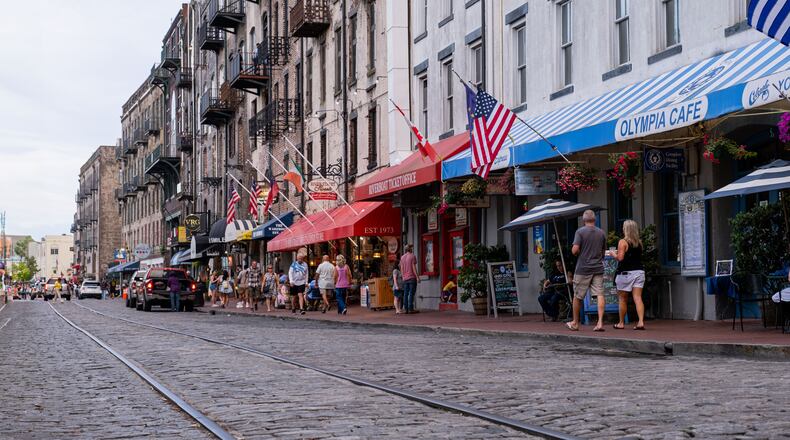Insider knowledge enhances a Savannah dining experience. In order to patronize restaurants in the city, you must navigate heat, humidity, problematic parking, crowds, ankle-turning cobblestones, seasonal menus, centuries-old buildings … and don’t forget those sand gnats.
To make the most of your time on the town, here’s what you need to know:
- River Street still is worth the trip. Once Savannah’s working waterfront, it morphed into a visitor destination in the 1970s and 1980s and is lined with eateries and drinking establishments. The recent transformation of a long-shuttered electrical power plant into a mini-resort known as the Plant Riverside District brought a number of dining options, including an upscale chophouse, a more casual pizza and pasta parlor and outdoor bars offering barbecue, seafood and burgers.
- Don’t worry if you’re ready to go and haven’t finished your drink yet. Downtown Savannah and Tybee Island don’t restrict open containers, and the Savannah city government has piloted “go-cup zones” in other parts of the city. Many places have stacks of clean plastic or aluminum cups at the door. When in doubt, ask a staffer.
- Is the seafood I’m ordering caught in nearby waters? That’s a question best answered by your server — and don’t be afraid to ask. Shrimpers work the coastal Georgia waters from mid-May to January, hauling in the sweet, briny catch. Crabbers are out year-round. Mahi, redfish, spotted trout, sheepshead and flounder are plentiful in the rivers and sounds around Savannah, and red snapper, cobia, red and black drums, grouper and amberjacks are favorites for local offshore fishing. As for oysters, the local varieties tend to be small and found in clusters. However, several Savannah restaurants sell oysters grown in cages in nearby rivers.
- The risk-reward of al fresco dining. Savannah’s weather lends itself to eating outdoors — until it doesn’t. Many favorite eateries offer outdoor seating; at some establishments, open-air tables may be the only option. Just know that what looks delightful might be uncomfortable, depending on the temperature, humidity level and — in the case of sand gnats — the time of day and year. If you want to dine al fresco, counter all these variables by picking an eatery with screened dining areas to keep the sun off your head, cooling fans or heaters blowing on your neck and gnats on the outside looking in.
- What about picnicking? Savannah has many perfect picnic days, and lots of picnic spots. Take a blanket and a to-go order and head to one of the downtown squares, Forsyth Park or the beach. Several city and county parks offer picnic shelters, as does Skidaway Island State Park. The best Lowcountry boil is done DIY-style, with shrimp fresh from the docks in Thunderbolt or on Tybee Island.
- More DIY. Savannah has places where you can shop for items you can prepare yourself, from farmers markets to specialty food stores. There’s a farmers market that offers restaurant-quality produce, meats, cheeses, breads and more every Saturday morning at the south end of Forsyth Park. Nearby is Brighter Day Natural Foods, a one-stop shop for healthy fare. Seafood markets dot the city, and Mexican bodegas and supermarkets are easy to find in western Chatham County, the population center for Savannah’s Hispanic communities.
- Don’t circle looking for a parking spot. Downtown Savannah was designed before the age of automobiles, and parking remained an afterthought for those who developed parts of the city after Henry Ford put a car in every garage. As a result, finding parking in the city can be maddening. However, the good news is that the best eateries are located in walkable parts of town, such as the historic district (1 square mile total) and Starland. Those headed downtown to eat don’t even have to park there; the local transit authority runs a fare-free trolley, known as the DOT, to shuttle riders into the heart of the city from areas on the edges, where street parking is more available.
- Beat the crowds. Savannah restaurants, especially the critically acclaimed ones, often are crowded. Plan to dine at off-peak hours for shorter waits and better service. For small parties, dining at the bar is a great option.
- Sometimes, it’s better just to stay home. Savannah is a party town, and there are weekends when trying that restaurant you’ve heard so much about just isn’t a wise move. The annual St. Patrick’s Day celebration disrupts life across the city, but especially downtown. The Beta Club national conference in June and the Every Woman’s Marathon in November will flood eateries with diners. Those headed for the beach will find Tybee’s relatively small number of restaurants slammed every weekend from Memorial Day to Labor Day.
- Do your homework. Savannah gets a little more cosmopolitan all the time, but the vegetarian and vegan options still can be limited; many restaurants are located in old buildings, where accessibility can be an issue; and some places operate with limited hours. Avoid disappointment by checking menus, facilities and hours of operation online before you go.
Credit: Rosana Lucia
Credit: Rosana Lucia
Sign up for the AJC Food and Dining Newsletter
Read more stories like this by liking Atlanta Restaurant Scene on Facebook, following @ATLDiningNews on X and @ajcdining on Instagram.
About the Author
More In This Series
The Darling Oyster Bar opens new location in Savannah and more from the coastal dining scene
Creative breweries in Athens add microdistilleries amid craft beer decline
An underground bar, a food truck fest and more from Savannah’s dining scene
Everything you need to know about the inaugural Hostess City Food and Wine Fest



